If you’re looking for a mid-range road bike, it’s likely it will come with either a Shimano Ultegra or 105 Di2 groupset.
Both of these performance groupsets from Shimano have electronic shifting, which Shimano calls Di2. This technology is increasingly trickling down into the mid-tier bike ranges and, relative to the ever-increasing price of bikes in general, is becoming more affordable.
Comparable in price to a quality set of premium wheels or many power meters, a groupset upgrade is also relatively affordable.
With Shimano’s top-spec Dura-Ace groupset costing significantly more than Ultegra or 105 Di2, many riders will be looking at a choice of Shimano Ultegra versus Shimano 105 Di2. But is there a reason to choose Shimano’s second-tier Ultegra groupset over its third-tier 105 Di2?
In this article, we'll compare the two groupsets and, based on our own testing and their highlighted differences, recommend whether most cyclists should be prioritising Ultegra or 105 Di2.
Shimano 105 Di2 and Ultegra at a glance
Shimano 105 Di2
- Shimano’s third-tier electronic-shifting groupset
- Same shifting logic as Shimano’s higher-spec electronic groupsets
- Disc brake only and some less advanced features than Shimano Ultegra and Dura-Ace
Shimano Ultegra
- One down from the top-spec Dura-Ace in Shimano’s groupset hierarchy
- More premium materials drop weight by around 373g from 105 Di2
- Disc and rim brake options and more different configurations than 105 Di2
Shimano 105 Di2 vs Ultegra: key stats
| Feature | 105 Di2 | Ultegra |
|---|---|---|
| Groupset weight (measured) | 2,950g | 2,577g |
| Groupset full retail price | £1,730 / $1,890 | £2,328 / $2,400 |
| Crankset options | 50/34t, 52/36t | 46/36t, 50/34t, 52/36t |
| Power meter option | N | Y |
| Cassette options | 11-34t, 11-36t | 11-30t, 11-34t |
| Shifting tech | Hyperglide | Hyperglide+ |
| Rim brake option? | N | Y |
| Third button on shifter? | N | Y |
| Satellite shifter compatible? | N | Y |
Shimano 105 Di2 vs Shimano Ultegra: components and features compared
Weight
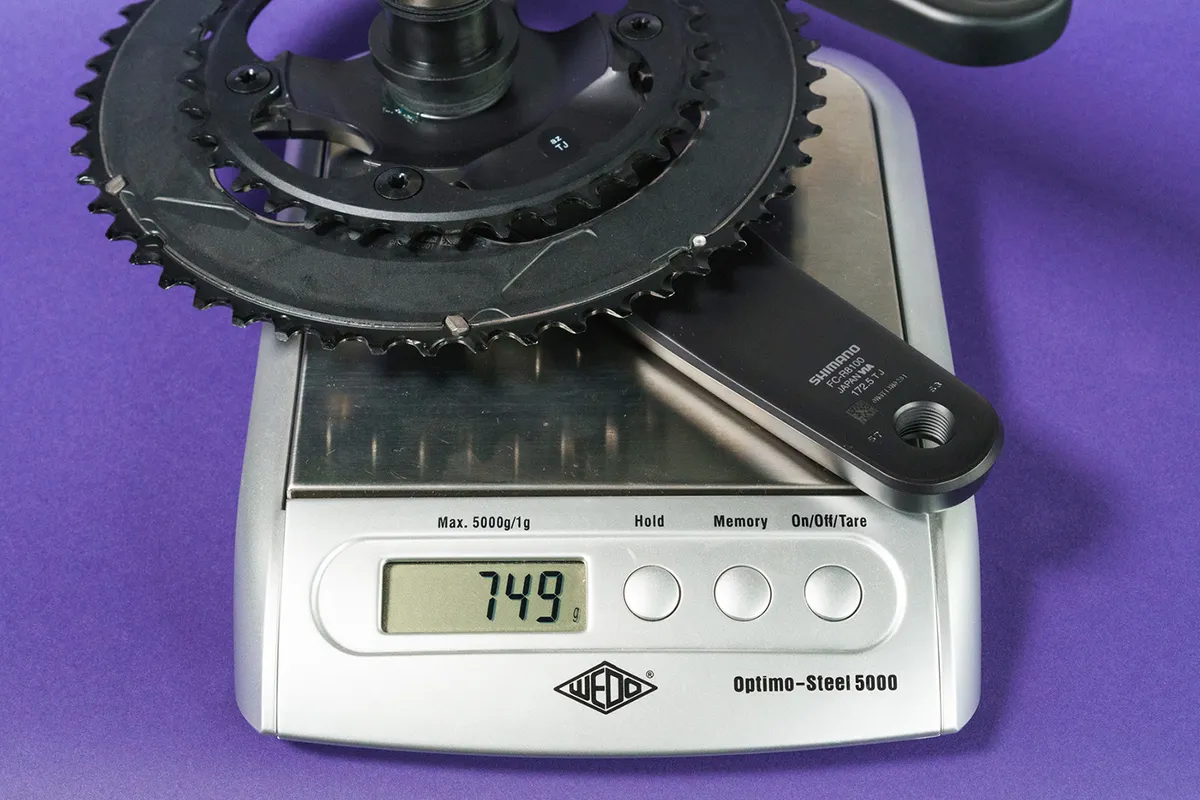
Most road riders look immediately at weight comparisons when choosing components. When we weighed the two groupsets, Shimano 105 Di2 came in at 2,950g which is 373g heavier than Ultegra.
The weight difference between the two groupsets is highly dependent on configuration. The choice of individual components such as the cassette and its range, the chainring pairing and crank length, and even the brake-rotor diameter can all affect the groupset weight.
Price
At full price, there’s a difference of more than £600 between the two groupsets. In reality, both are usually heavily discounted, so the real-world price difference may only be £300 or less if you shop around.
If you’re looking at complete road bikes, the difference in price between a 105 Di2-equipped bike and a similar Ultegra-equipped machine is likely to be in part due to other factors, principally wheel choice and possibly the carbon grade used in the frameset.
Shifters

The shifters of Shimano 105 Di2 are similar in size and shape to those of Ultegra. They’re a bit weightier (442g versus 385g a pair) due to different materials.
The 105 levers also don’t incorporate the third button on the hoods seen in Ultegra, which can be set up, for example, to scroll through the screen on a bike computer.
You can’t add satellite shifters either, which can be placed on the bar tops or drops to enable you to shift gears from there.
Although Shimano has adjusted the shift-button ergonomics, in both 105 Di2 and Ultegra it’s still fairly easy to hit the wrong shifter, particularly when wearing heavier gloves.
Crankset
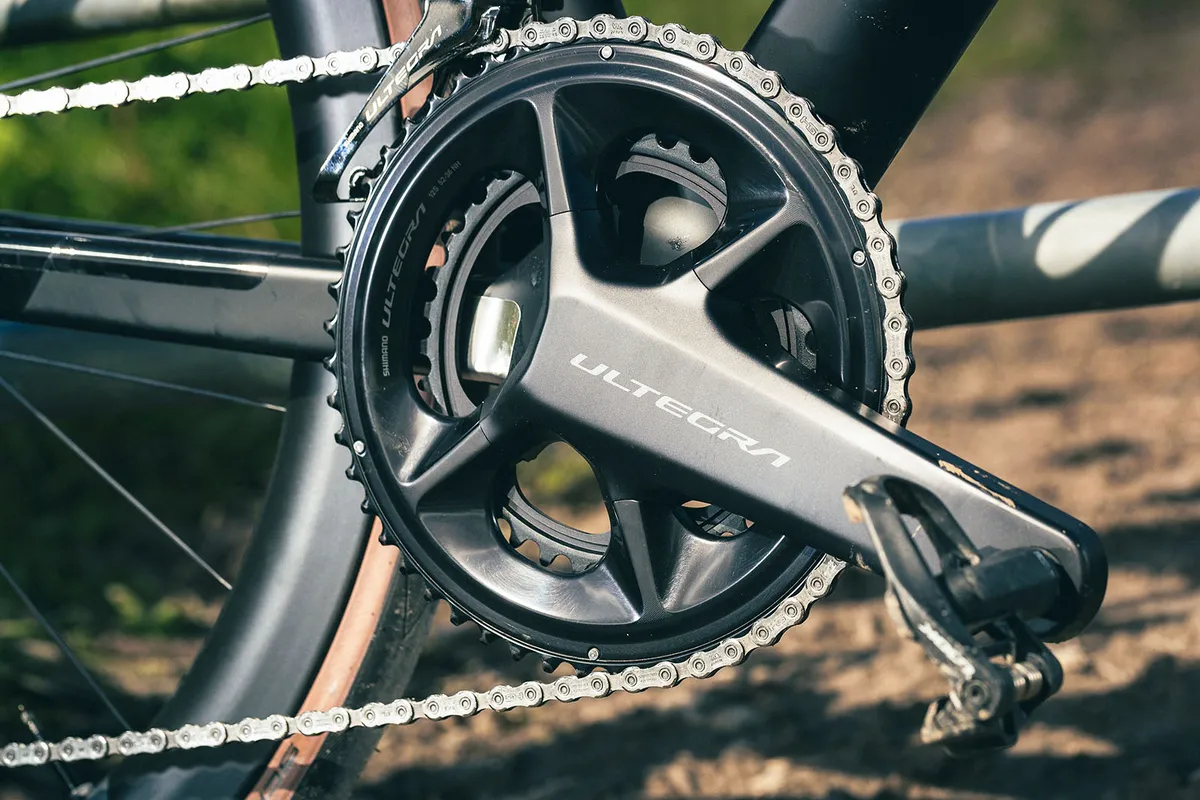
The cranksets of 105 Di2 and Ultegra are near-identical, although there’s a slight weight difference (767g vs 749g in our testing). 105 Di2 (and 105 mechanical) also offers an out-of-series RS520 model.
Both groupsets have 50/34t and 52/36t ratios available, but Ultegra also offers a 46/36t for cyclocross riders who haven’t opted for a 1x drivetrain.
Neither groupset has a pro-style 54/40t option – you’ll need Dura-Ace for that. Crank-length options are identical and range from 160mm to 175mm.
Shimano doesn't offer a power meter for 105, while it does for Ultegra. However, there are plenty of third-party power meter options, including 4iiii’s instrumented cranks and pedal power meters if you want to ride 105 and measure your power output.
Pedals
There are minor differences between Ultegra pedals and 105 pedals. Both are made of carbon composite and while Ultegra pedals weighed 247g in our testing, 105 pedals weighed 258g. Shimano claims a slightly greater weight difference though. Both use identical SPD-SL cleats.
The stack height, which may affect pedalling efficiency, is slightly lower in Ultegra at 15.8mm versus 16.5mm. The Ultegra pedals are available with a 4mm longer axle as an option, should you want a wider stance width.
Front derailleur

The front derailleur motor housing on the latest-generation Ultegra and Dura-Ace has been slimmed down for a less bulbous look and encloses a smaller, more powerful motor.
In contrast, the 105 Di2 housing is the same size and shape as that of the previous-generation Ultegra Di2. It looks a little ugly and the previous-generation motor is less powerful and slower to act, but it’s by no means a show-stopper.
Rear derailleur
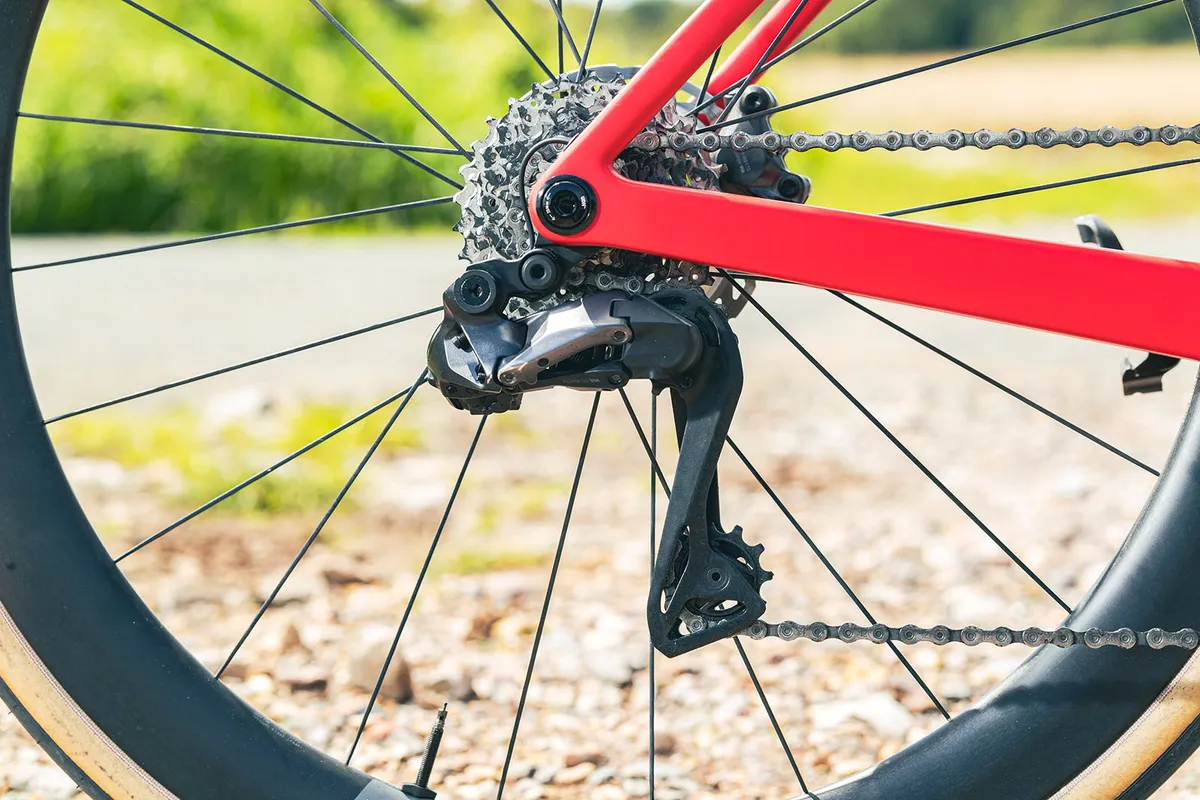
The differences between rear derailleurs are even less marked. The 105 Di2 model is a bit less sculpted, but performs near-identically to Ultegra. Both house the battery charge port and Bluetooth receiver.
Neither is cheap to replace, at around £275 for 105 Di2 and £380 for Ultegra.
Cassettes
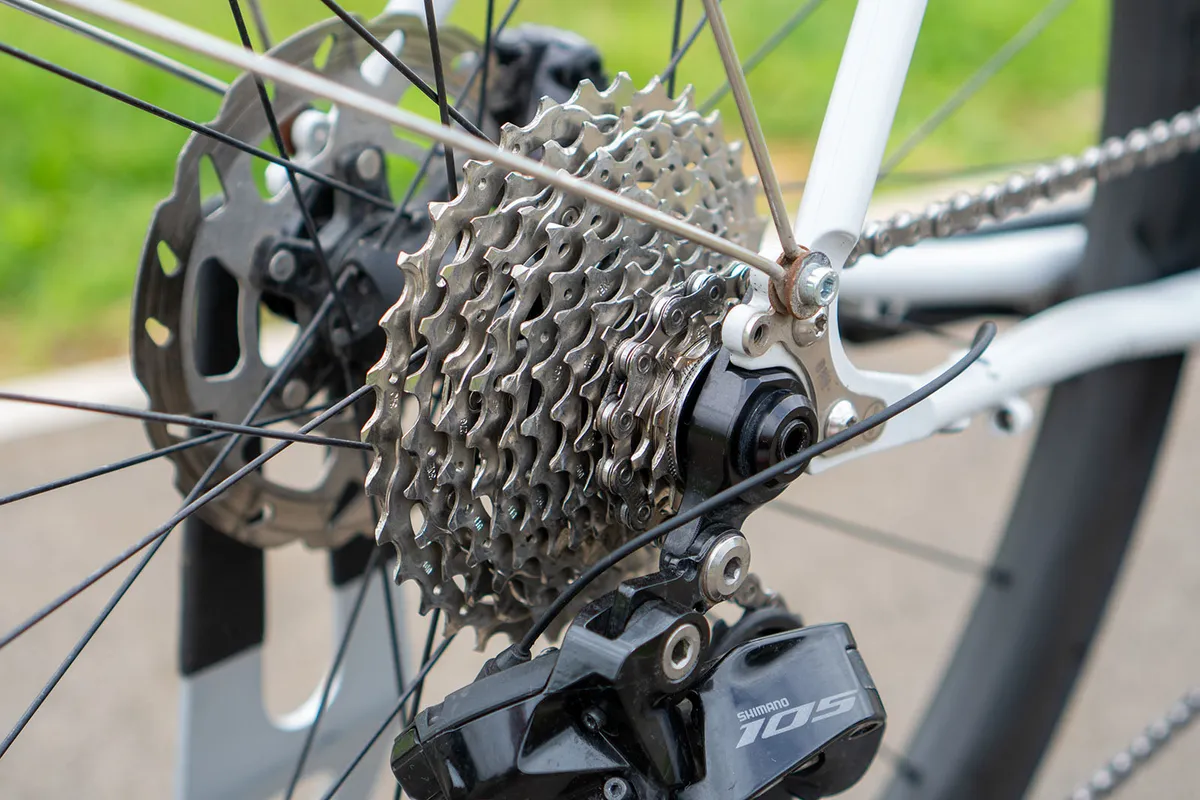
While Ultegra can be had with an 11-30t or an 11-34t cassette, 105 has an in-series 11-34t option only, although there’s a compatible 11-36t available from Shimano. Again, there’s a weight difference between the two 11-34t cassette options (342g vs 360g).
We ran 105 Di2 completely satisfactorily with an 11-30t Ultegra cassette, despite Shimano not advising this.
Ultegra uses Hyperglide+ tooth profiles, while 105 has older-standard Hyperglide. We found the latter slightly less smooth and a little louder when shifting, when reviewing back-to-back. However, as with front shifting, it’s not something you’re likely to notice when riding.
Shifting speed
Hyperglide+ tech, seen initially in Shimano’s MTB groupsets, is claimed to provide easier shifting under loads.
Alongside new motors and electronics, Shimano claims this increases shifting speed by 58 per cent at the rear and 45 per cent at the front relative to its previous-generation, 11-speed electronic groupsets.
In contrast, 105 Di2 has remained with the Hyperglide shifting and older-generation motors.
Does this make a discernible difference?
We noted the slower shift speed in our review, relative to Ultegra, particularly for an upshift between chainrings. That shifting is nevertheless almost faultless. The slower shifts could be felt when we rode the two groupsets back-to-back, but it wasn't something we noticed after a few miles of riding.
Chain management
While SRAM incorporates a clutch in its 12-speed rear derailleurs, neither Ultegra nor 105 Di2 include one. Thus they’re both prone to chain clatter on rougher roads or if you decide to take an excursion off-road.
If you frequently ride gravel and want to avoid this, you might want to look at Shimano GRX RX825 Di2, which includes a clutch.
Batteries
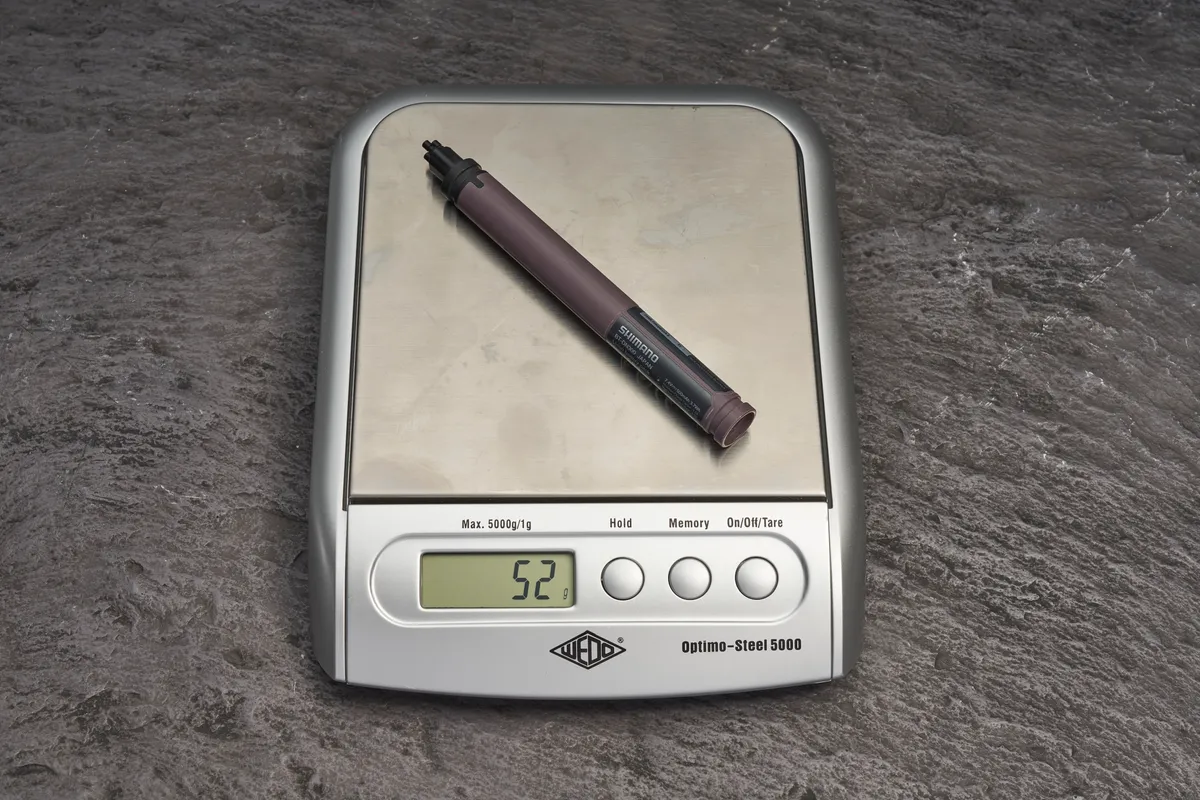
It’s easy to fit and forget with electronic-shifting batteries – a mistake that has left us riding 1x or even single-speed on more than one occasion, despite Shimano’s claim of 1,000km range between charges.
105 Di2 and Ultegra both use the same central battery, hidden somewhere in the bike’s tubing, to power the front and rear derailleurs, so there’s no reason here to choose one over the other. Both are charged via a USB cable connected to the same design of charging port on the rear derailleur too.
The semi-wireless connection between the shifters and the derailleurs uses coin cells to power the wireless transmitter in the shifters. Here, 105 Di2 makes up for the lack of a third shift button by using the space to house two CR1932 lithium coin cells, rather than Ultegra’s single one.
In theory, this gives you twice the battery life before you need to replace them, but even Ultegra has a claimed runtime of between 18 months and two years, so as long as you keep an eye on the battery level periodically, you’re unlikely to run out of juice.
Braking
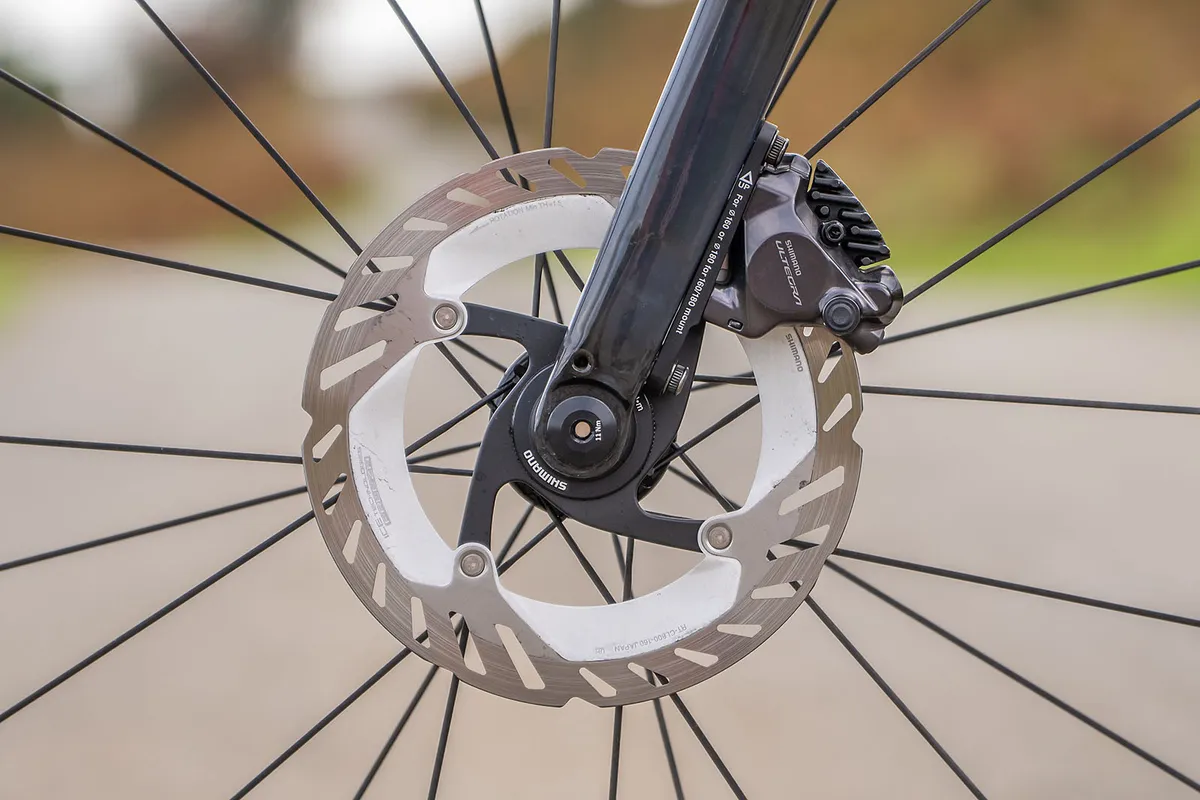
Both Ultegra and 105 Di2 have a hydraulic disc brake option, but only Ultegra also handles rim brakes, albeit with different shifters.
Both 105 Di2 and Ultegra’s disc brake pads retract a 10 per cent greater distance than in Shimano’s previous-generation groupsets, so brake rub is less likely.
Ultegra disc brakes include the same Servo Wave tech as Dura-Ace. This offers non-linear brake pad progression, so the pad starts to engage sooner in the lever stroke and there is a smoother bite as you go deeper into the stroke.
While 105 brakes don’t include Servo Wave, it’s not something that affects the excellent brake modulation and power on offer.
They also don’t incorporate Freezr heat sink fins. This isn’t something that had a noticeable effect in our testing, although the brakes might possibly be more prone to fade on long descents.
Configuration

Both groupsets use the same E-Tube Project app to monitor battery life, adjust their performance characteristics to your preferences and update their firmware. The app is slick, works over Bluetooth and is easy to use.
Shimano 105 Di2 vs Shimano Ultegra: what do our reviewers say?
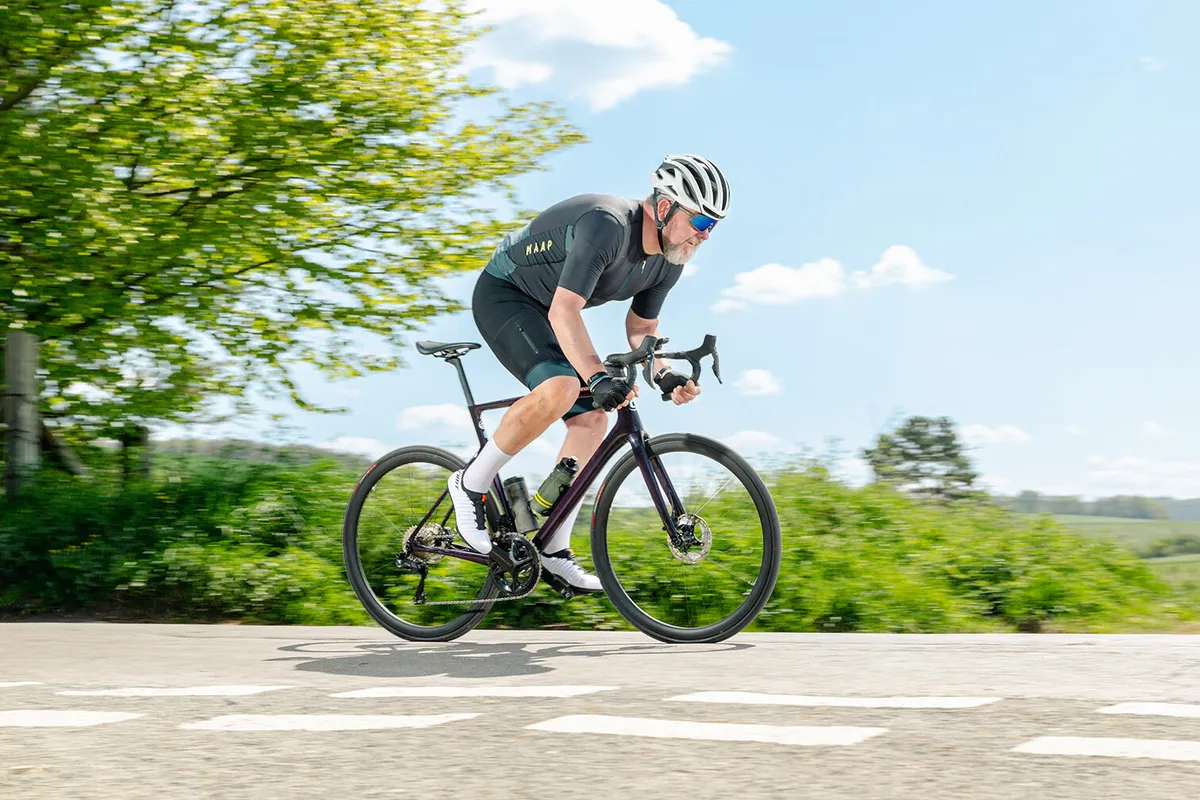
Needless to say, we have comprehensive reviews of both Ultegra and 105 Di2.
When we reviewed Ultegra, we posed the question: does anyone actually need Dura-Ace? Ultegra and Dura-Ace share their motors and electronics, and we noted the smooth shifting and easier configurability than its predecessors.
We reckoned 105 Di2 shifted a little slower than Ultegra, which was particularly noticeable in the front. Likewise, the absence of souped-up Hyperglide+ made for a little more rear-shifting noise. Although the difference could be discerned immediately after jumping from one groupset to the other, neither was something we continued to notice or that unduly impacted the ride experience though.
Meanwhile, if you want the nuts and bolts (literally) of the components and their weights for each groupset, you can read our item-by-item groupset weigh-ins and watch the embedded videos for 105 Di2 and Ultegra.
Shimano 105 Di2 vs Shimano Ultegra: which should you choose?
Electronic shifting makes it increasingly difficult for groupset manufacturers to differentiate between the tiers of their groupset hierarchies. Unless they make a perverse decision to downgrade something, the electronics and shifting are almost identical between groupsets.
So it is with Shimano Ultegra and 105 Di2. The latter removes some nice-to-haves at the margins, but most riders won’t judge these critical and the ride experience is near-identical.
The majority of riders will be choosing between buying a complete road bike specced with either Ultegra or 105 Di2, rather than looking to upgrade their groupset. As such, the 373g or so difference in weight is more than likely to be outweighed by differences in other parts of the bike spec, such as carbon grade and manufacturers’ wheel and tyre choices.
Unless you’re looking for a specialised configuration, such as a 46/36t cyclocross groupset (or rim brakes), are a die-hard weight weenie (in which case we’d point you to Dura-Ace), or want satellite shifters or an in-series power meter, there’s little reason to choose Ultegra over 105 Di2.





